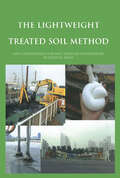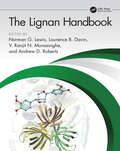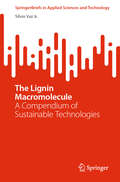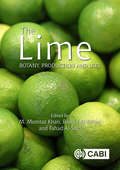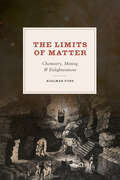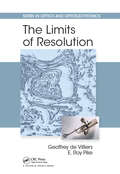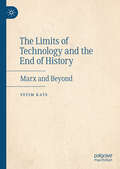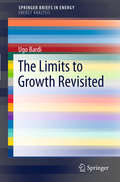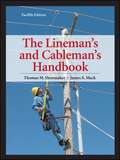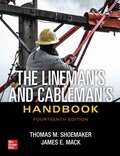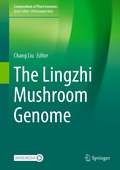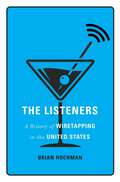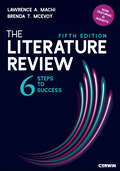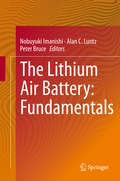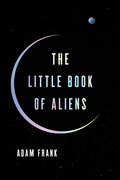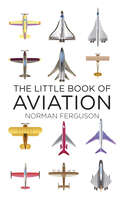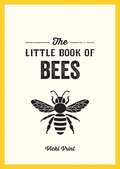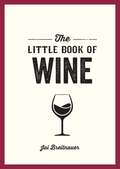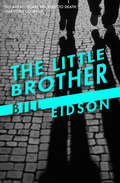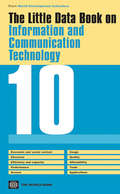- Table View
- List View
The Lightweight Treated Soil Method: New Geomaterials for Soft Ground Engineering in Coastal Areas
by Takashi Tsuchida Kazuhiko EgashiraThis is an in-depth practical examination of the newly developed Lightweight Treated Soil Method, based on the extensive research and experience of two leading recognized experts. Indispensable to geotechnical and construction engineers or to researchers and professionals interested in coastal engineering techniques, geotechnical engineering or geo
The Lignan Handbook
by Norman G. Lewis Laurence B. Davin V. Ranjit N. Munasinghe Andrew D. RobertsLignans are aromatic compounds isolated from plants. This handbook presents an authoritative and comprehensive review of lignan chemistry, biochemistry, nomenclature, uses, and occurrence. Lignans are used in a wide variety of industries and this book will appeal to those working in the pulp and paper industries, renewable energy, specialty chemicals, pharmaceuticals, flavors and fragrances, agriculture and forestry, evolution and ecology. Additionally, the book features a comprehensive lignans dictionary section, drawn from the prestigious Dictionary of Natural Products. Other features include: Presents a comprehensive and up-to-date account of this important group of natural products Addresses and resolves problems in current lignan nomenclature Edited by the leaders in the field of lignan chemistry and biochemistry
The Lignin Macromolecule: A Compendium of Sustainable Technologies (SpringerBriefs in Applied Sciences and Technology)
by Silvio Vaz Jr.This book covers lignin, a renewable source of carbonaceous material derived from biomass, which is a subject of research, development and innovation in both academia and industry. From lignin we can obtain chemicals (e.g., aromatics, phenols), materials (e.g., fibres, engineered plastics, modified polymers), specialties (e.g., additives as antioxidant), among other products in diverse levels of technology readiness. However, there are challenges to overcome in terms of chemical structure, industrial yields of conversion processes, and the quality of raw material in order to reach the best uses and applications according to the sustainability vision for products and processes. This book deals with the main biochemical pathways of synthesis; advanced analytical techniques; extraction strategies; chemical, biochemical, biological, and physical processing for chemicals and materials; circularity and sustainability aspects for actual and future production chains, allied to life cycle assessment and industrial ecology.
The Lime
by M. Mumtaz Khan Rashid Al-Yahyai Fahad Al-SaidThis book is a comprehensive and up-to-date resource covering the botany, production and uses of limes. The lime is an important fruit crop throughout citrus producing regions of the world, with its own specific benefits, culture and marketplace, but producers face issues affecting successful cultivation and production. The Lime: Botany, Production and Uses contains detailed information on: #65533; Breeding, genetics and biodiversity of limes #65533; Orchard establishment, management and precision agriculture #65533; Pests and diseases, including the latest knowledge regarding current threats such as Witches' Broom Disease and Citrus Greening #65533; Harvesting and postharvest management #65533; Traditional and commercial uses of limes Authored by an international team of experts and presented in full colour throughout, this book is an essential resource for academic researchers and specialist extension workers, in addition to growers and producers involved in the citrus industry.
The Limits of Matter: Chemistry, Mining, and Enlightenment
by Hjalmar ForsBy studying the chemists at the Swedish Bureau of Mines and their networks, and integrating their practices into the wider European context, the author illustrates how they and their successors played a significant role in the development of our modern notion of matter and made a significant contribution to the modern European view of reality.
The Limits of Resolution (Series in Optics and Optoelectronics)
by Geoffrey de Villiers E. Roy Pike"This beautiful book can be read as a novel presenting carefully our quest to get more and more information from our observations and measurements. Its authors are particularly good at relating it." --Pierre C. Sabatier "This is a unique text - a labor of love pulling together for the first time the remarkably large array of mathematical and statistical techniques used for analysis of resolution in many systems of importance today – optical, acoustical, radar, etc…. I believe it will find widespread use and value." --Dr. Robert G.W. Brown, Chief Executive Officer, American Institute of Physics "The mix of physics and mathematics is a unique feature of this book which can be basic not only for PhD students but also for researchers in the area of computational imaging." --Mario Bertero, Professor, University of Geneva "a tour-de-force covering aspects of history, mathematical theory and practical applications. The authors provide a penetrating insight into the often confused topic of resolution and in doing offer a unifying approach to the subject that is applicable not only to traditional optical systems but also modern day, computer-based systems such as radar and RF communications." --Prof. Ian Proudler, Loughborough University "a ‘must have’ for anyone interested in imaging and the spatial resolution of images. This book provides detailed and very readable account of resolution in imaging and organizes the recent history of the subject in excellent fashion.… I strongly recommend it." --Michael A. Fiddy, Professor, University of North Carolina at Charlotte This book brings together the concept of resolution, which limits what we can determine about our physical world, with the theory of linear inverse problems, emphasizing practical applications. The book focuses on methods for solving illposed problems that do not have unique stable solutions. After introducing basic concepts, the contents address problems with "continuous" data in detail before turning to cases of discrete data sets. As one of the unifying principles of the text, the authors explain how non-uniqueness is a feature of measurement problems in science where precision and resolution is essentially always limited by some kind of noise.
The Limits of Technology and the End of History: Marx and Beyond
by Yefim KatsThis book examines the long-standing belief in infinite scientific and technological progress and links it to the Enlightenment ideal of man as a universal being and subject of the universal world history, destined to become a 'master and possessor of nature.' The author analyzes a broad range of issues in epistemology, the philosophy of history, and the philosophy of science and technology. Marx’s philosophy is explored to the extent that his dialectic of labor sheds light on Western technological optimism and the ideal of human universality and offers an elaborate framework for analyzing the intrinsic limits to technological progress. The focus is on his ‘early’ works, providing a theoretical and humanistic underbelly for the ‘mature’ ideas of the Capital. Examining the epistemic foundations of the belief in infinite progress, the author argues that actual infinity, either in the form of unbounded technological/scientific expansion or infinite complexity of nature, is redundant for the universality of man, his scientific pursuit and historical experience. The conundrum of universality and power calls for a systematic critique of instrumental reason, its practical applicability and value structure.
The Limits to Growth Revisited
by Ugo Bardi"The Limits to Growth" (Meadows, 1972) generated unprecedented controversy with its predictions of the eventual collapse of the world's economies. First hailed as a great advance in science, "The Limits to Growth" was subsequently rejected and demonized. However, with many national economies now at risk and global peak oil apparently a reality, the methods, scenarios, and predictions of "The Limits to Growth" are in great need of reappraisal. In The Limits to Growth Revisited, Ugo Bardi examines both the science and the polemics surrounding this work, and in particular the reactions of economists that marginalized its methods and conclusions for more than 30 years. "The Limits to Growth" was a milestone in attempts to model the future of our society, and it is vital today for both scientists and policy makers to understand its scientific basis, current relevance, and the social and political mechanisms that led to its rejection. Bardi also addresses the all-important question of whether the methods and approaches of "The Limits to Growth" can contribute to an understanding of what happened to the global economy in the Great Recession and where we are headed from there.
The Lineman's and Cableman's Handbook
by Thomas M. Shoemaker James E. MackThe definitive guide to distribution and transmission line technology--fully updated Completely revised to reflect the 2012 National Electrical Safety Code (NESC), The Lineman's and Cableman's Handbook, 12th Edition, provides in-depth information on overhead and underground distribution and transmission lines. The latest OSHA, ANSI, and ASTM standards are emphasized throughout. This authoritative resource presents basic principles, equipment, standards, and safety regulations, allowing electrical workers to avoid costly errors, diagnose and repair power failures, and ensure optimum safety. A wealth of illustrations and photographs make it easy to understand the material, and self-test questions and exercises help reinforce key concepts. Comprehensive coverage includes: Electrical principles and systems * Substations * Circuits * Construction * Wood-pole, aluminum, concrete, fiberglass, and steel structures * Distribution automation * Emergency system restoration * Unloading, hauling, erecting, setting, and guying poles * Insulators, crossarms, and conductor supports * Line conductors * Distribution transformers * Lightning and surge protection * Fuses * Switches, sectionalizers, and reclosers * Voltage regulators * Transmission tower erection * Stringing, sagging, and joining line conductors * Live-line maintenance * Grounding * Street lighting * Underground distribution * Vegetation management * Distribution transformer installation * Electrical drawing symbols * Single-line and schematic diagrams * Voltage regulation * Units of measurement, electrical definitions, electrical formulas, and calculations * Maintenance of transmission and distribution lines * Rope, knots, splices, and gear * Climbing and wood poles * Protective equipment * OSHA 1910. 269 * Resuscitation * Pole-top and bucket rescue
The Lineman's and Cableman's Handbook
by Thomas M. Shoemaker James E. MackThe definitive guide to distribution and transmission line technology―fully revised for the latest standards <P><P>Thoroughly updated to reflect the 2023 National Electrical Safety Code® (NESC®), this classic resource explains the principles and practices of electric transmission and distribution line construction, operation, and maintenance. You will get comprehensive coverage of the newest equipment, techniques, and procedures along with current OSHA, ANSI, and ASTM regulations. Detailed illustrations and photos make it easy to understand the material, and self-test questions and exercises reinforce key concepts. An industry standard since 1928, this guide also serves as a valuable on-the-job reference for electric transmission and distribution grid system professionals.
The Lingzhi Mushroom Genome (Compendium of Plant Genomes)
by Chang LiuThis book becomes an invaluable reference on the genetic resources, genome, genes, chemical compounds, and their therapeutic effects for the Lingzhi mushrooms. It is the first comprehensive compilation of genetic resources, nuclear genome, mitochondrial genome, genes, noncoding RNAs, such as long intergenic noncoding RNAs, microRNAs, circular RNAs, genes in the biosynthetic pathway, chemical compounds and their therapeutic effects, transformation system for the expression of key genes, a bibliometric analysis to identify the past research work and the future research direction, and a survey of products derived from the Lingzhi mushrooms. Each chapter of this book is written by authors of globally reputed experts on the relevant field who had published high-quality articles in the corresponding subject. The book has 12 chapters and each chapter has a length of approximately ten thousand words, including ten items (tables or figures), about 30–50 references. This book is useful to the students, teachers, and scientists in academia and relevant private companies interested in horticulture, genetics, physiology, molecular genetics, and breeding, in vitro culture and genetic engineering, and structural and functional genomics. This book is also useful to seed and pharmaceutical industries.
The Lipid Handbook with CD-ROM
by Frank D. Gunstone John L. HarwoodExtensively revised, reorganized, and expanded, the third edition of the industry standard, The Lipid Handbook reflects many of the changes in lipid science and technology that have occurred in the last decade. It places a stronger emphasis on the nutritional, medical, and agricultural aspects of lipids to reflect the increased interest and research in these areas in the past 10 years and beyond. This edition features updated chapters and expanded coverage, including additional compounds to its dictionary. Written by experts from a diverse range of fields, many of whom have contributed new research in the areas under review, this handbook remains an essential reference.
The Listeners: A History of Wiretapping in the United States
by Brian HochmanThey’ve been listening for longer than you think. A new history reveals how—and why. Wiretapping is nearly as old as electronic communications. Telegraph operators intercepted enemy messages during the Civil War. Law enforcement agencies were listening to private telephone calls as early as 1895. Communications firms have assisted government eavesdropping programs since the early twentieth century—and they have spied on their own customers too. Such breaches of privacy once provoked outrage, but today most Americans have resigned themselves to constant electronic monitoring. How did we get from there to here? In The Listeners, Brian Hochman shows how the wiretap evolved from a specialized intelligence-gathering tool to a mundane fact of life. He explores the origins of wiretapping in military campaigns and criminal confidence games and tracks the use of telephone taps in the US government’s wars on alcohol, communism, terrorism, and crime. While high-profile eavesdropping scandals fueled public debates about national security, crime control, and the rights and liberties of individuals, wiretapping became a routine surveillance tactic for private businesses and police agencies alike. From wayward lovers to foreign spies, from private detectives to public officials, and from the silver screen to the Supreme Court, The Listeners traces the long and surprising history of wiretapping and electronic eavesdropping in the United States. Along the way, Brian Hochman considers how earlier generations of Americans confronted threats to privacy that now seem more urgent than ever.
The Litani River, Lebanon: An Assessment and Current Challenges (Water Science and Technology Library #85)
by Amin Shaban Mouin HamzéThis book presents a collection of chapters covering research on the Litani River Basin. The Litani River Basin occupies about a quarter of Lebanon's surface area, and it has recently been subject to severe geo-environmental conditions such as water contamination and decreased discharge. This motivated the Lebanese government to take action and start working on the remediation of the river. These actions are also supported by international organizations including the World Bank.
The Literature Review: Six Steps to Success
by Brenda T. McEvoy Lawrence A. MachiExpert guidance and cutting-edge tools for every researcher. Complex, time-consuming, and steeped in methodologies, conducting a literature review can often feel overwhelming. A go-to resource for researchers for nearly 20 years, The Literature Review simplifies the process with a structured six-step model to narrow your research topic, focus your literature search, negotiate the myriad of books, periodicals, and reports about your topic—and, of course, write the review. The fifth edition of this bestselling book includes step-by-step guidance on how to use artificial intelligence ethically and effectively across the six steps of the literature review process. Additional features of this thoroughly updated guide include: Practical checklists, templates, and visuals to support your research at every stage. Reflective exercises, learning tips, and questions to ensure a deeper understanding of each process. Recommendations on transparency and responsibility when utilizing AI in academic research. Whether you’re embarking on your first literature review or refining your skills, this book equips you with the tools needed to tackle every stage of the literature review process with clarity and precision.
The Literature Review: Six Steps to Success
by Brenda T. McEvoy Lawrence A. MachiExpert guidance and cutting-edge tools for every researcher. Complex, time-consuming, and steeped in methodologies, conducting a literature review can often feel overwhelming. A go-to resource for researchers for nearly 20 years, The Literature Review simplifies the process with a structured six-step model to narrow your research topic, focus your literature search, negotiate the myriad of books, periodicals, and reports about your topic—and, of course, write the review. The fifth edition of this bestselling book includes step-by-step guidance on how to use artificial intelligence ethically and effectively across the six steps of the literature review process. Additional features of this thoroughly updated guide include: Practical checklists, templates, and visuals to support your research at every stage. Reflective exercises, learning tips, and questions to ensure a deeper understanding of each process. Recommendations on transparency and responsibility when utilizing AI in academic research. Whether you’re embarking on your first literature review or refining your skills, this book equips you with the tools needed to tackle every stage of the literature review process with clarity and precision.
The Lithium Air Battery
by Nobuyuki Imanishi Alan C. Luntz Peter BruceLithium air rechargeable batteries are the best candidate for a power source for electric vehicles, because of their high specific energy density. In this book, the history, scientific background, status and prospects of the lithium air system are introduced by specialists in the field. This book will contain the basics, current statuses, and prospects for new technologies. This book is ideal for those interested in electrochemistry, energy storage, and materials science.
The Little Book of Aliens
by Adam Frank“With wit and brio, Frank separates current nonsense about aliens from the serious and fascinating search for extraterrestrial life.” —Carlo Rovelli, New York Times bestselling author of Seven Brief Lessons on PhysicsFrom astrophysicist Adam Frank, a little book on the biggest questions in our search for extraterrestrial life, questions we stand ready to answer.Everyone is curious about life in the Universe, UFOs and whether ET is out there. Over the course of his thirty-year career as an astrophysicist, Adam Frank has consistently been asked about the possibility of intelligent life in the universe. Are aliens real? Where are they? Why haven’t we found them? What happens if we do?We’ve long been led to believe that astronomers spend every night searching the sky for extraterrestrials, but the truth is we have barely started looking. Not until now have we even known where to look or how. In The Little Book of Aliens, Frank, a leading researcher in the field, takes us on a journey to all that we know about the possibility of life outside planet Earth and shows us the cutting-edge science that has brought us to this unique moment in human history: the one where we go find out for ourselves.In this small book with big stakes, Frank gives us a rundown of everything we need to know, from the scientific origins of the search for intelligent life, the Fermi Paradox, the Kardashev Scale, the James Webb Telescope, as well as UFOs and their conspiracy theories. Drawing from his own work and that of other scientists studying the possibility of alien life, he brings together the latest scientific thinking, data, ideas, and discoveries to equip us with the critical facts as we stand at what may be the last moment in human history where we still believe we are all alone. This book is about everything we do—and do not—know about life, intelligent or otherwise beyond Earth. In language that is engaging, entertaining and fun, The Little Book of Aliens provides a comprehensive first look at how close we are to finding out if others actually exist—and if they do, what they might be like.Humankind is on the precipice of finding its neighbors. What comes next? No person is better suited to answer that question—and lead the search—than Adam Frank.
The Little Book of Aviation (Little Book Of)
by Norman FergusonThe Little Book of Aviation is a collection of facts, figures and interesting stories from the world of flight. Sad, humorous, baffling and astounding stories abound, from the pioneering days of the Wright Brothers to the present day, and covering everything from great milestones, famous names who’ve served, and the greatest of aircraft icons; phantom pilots and aircraft and a glossary of slang; the origins of plane-spotting and unusual aircraft names; great feats and enduring mysteries; lucky escapes and great aircraft in the movies… the trivia is limitless and will appeal to everyone, whether you want help telling your Spitfire from your Messerschmitt or you know a Spitfire I from a Spitfire II!
The Little Book of Bees: A Pocket Guide to the Wonderful World of Bees
by Vicki VrintDiscover the fascinating story of these marvels of nature. Learn about their beehaviours, why they are under threat and how they are essential to our existence. From tips to help identify different species to bee habitats and folklore, this is the ideal companion for any bee lover looking to protect the future of our furry little friends.
The Little Book of Bees: A Pocket Guide to the Wonderful World of Bees
by Vicki VrintDiscover the fascinating story of these marvels of nature. Learn about their beehaviours, why they are under threat and how they are essential to our existence. From tips to help identify different species to bee habitats and folklore, this is the ideal companion for any bee lover looking to protect the future of our furry little friends.
The Little Book of Wine: A Pocket Guide to the Wonderful World of Wine Tasting, History, Culture, Trivia and More
by Jai BreitnauerWhether you're a qualified quaffer or an aspiring aficionado, raise a glass to the wonders of wine with this vintage blend of culture, history and trivia Pinot, Chardonnay, Merlot, Riesling... There are so many delicious varieties of wine to delight both the nose and palate - and no other beverage has ever created such excitement and emotion over its vast history. It's also a subject whose complexities can be baffling and mysterious to the uninitiated. Luckily, this small but full-bodied pocket guide is here to unveil all the secrets of this most marvellous drink. Packed with a wealth of information on the world of wine, this miscellany is the perfect gift for any wine fan, from the seasoned expert to the casual drinker. Whether you favour red or white, dry or sweet, sparkling or still, indulge your inner sommelier and celebrate the gift of the grape with The Little Book of Wine.
The Little Book of Wine: A Pocket Guide to the Wonderful World of Wine Tasting, History, Culture, Trivia and More
by Jai BreitnauerWhether you're a qualified quaffer or an aspiring aficionado, raise a glass to the wonders of wine with this vintage blend of culture, history and trivia Pinot, Chardonnay, Merlot, Riesling... There are so many delicious varieties of wine to delight both the nose and palate - and no other beverage has ever created such excitement and emotion over its vast history. It's also a subject whose complexities can be baffling and mysterious to the uninitiated. Luckily, this small but full-bodied pocket guide is here to unveil all the secrets of this most marvellous drink. Packed with a wealth of information on the world of wine, this miscellany is the perfect gift for any wine fan, from the seasoned expert to the casual drinker. Whether you favour red or white, dry or sweet, sparkling or still, indulge your inner sommelier and celebrate the gift of the grape with The Little Book of Wine.
The Little Brother
by Bill EidsonBill Eidson&’s first novel is an early and frightening look at the concept of identity theft. When Boston-based dive shop owner, Rod Konrad, runs short of money, he decides to share his apartment. Bette, his girlfriend, isn&’t ready to move in, so he places an ad for a roommate. Brendan is nice enough—as nice as a stranger invading your home can be. He certainly takes to Rod. But isn't he trying too hard? He talks like Rod, acts like him, and is always just a little too close. Left unchecked, he&’ll not only steal Rod&’s clothes—but his life.THE LITTLE BROTHER is a fast, dark thriller that tackles the very concept of who we are."Ever advertised for a roommate, and feared the stranger who is about to share your digs is a psychopath? Go ahead; scare yourself to death."—Hartford Courant"One of the joys of reviewing is the discovery of a major new talent. [Bill Eidson has]...constructed a fascinating, terrifying psychological profile that ranks with the best and needs to be recognized by awards committees. Highly recommended."—Mystery News"There is something undeniably intriguing about the relentlessness and almost gleeful inventiveness that Nolan...brings to his demented, homicidal obsession..."—The Washington Post"It will make you avoid dark hallways and sense something sinister behind a friendly stranger's smile. The novel crawls with suspense. If the story grips you, THE LITTLE BROTHER may have you by the throat."—The Pittsburgh Press
The Little Data Book on Information and Communication Technology 2010
by World BankThis Little Data Book presents at-a-glance tables for over 140 economies showing the most recent national data on key indicators of information and communications technology (ICT), including access, quality, affordability, efficiency,sustainability, and applications.
